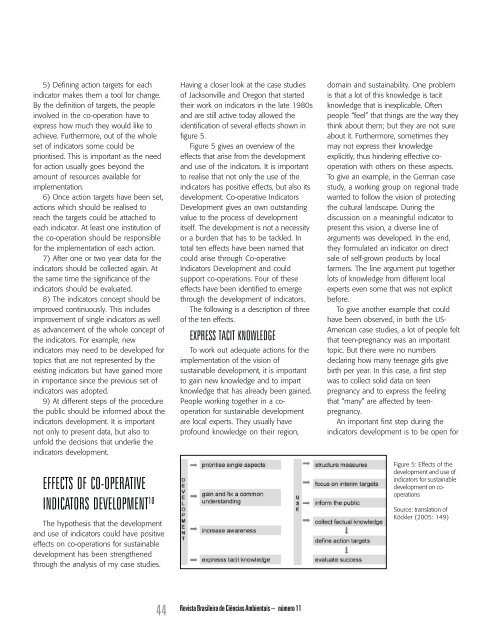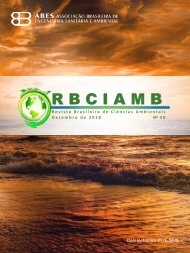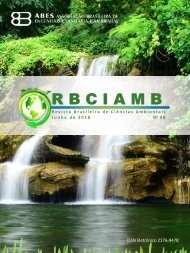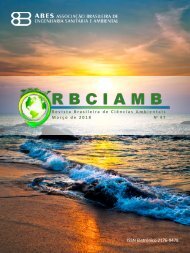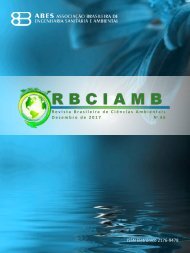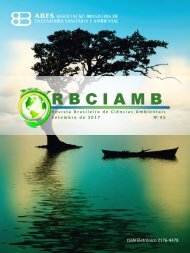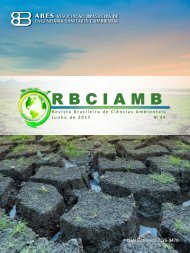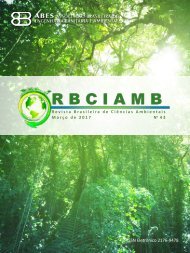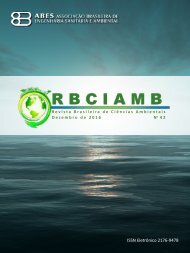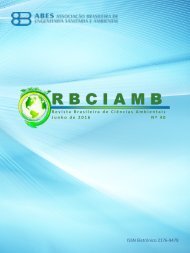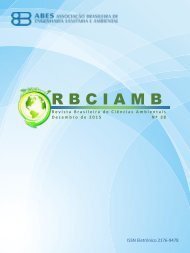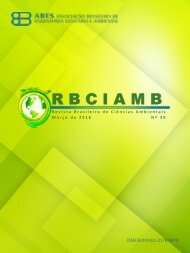EDIÇÃO 11 - Dezembro/08 - RBCIAMB
A Revista Brasileira de Ciências Ambientais – RBCIAMB - publica artigos completos de trabalhos científicos originais ou trabalhos de revisão com relevância para a área de Ciências Ambientais. A RBCIAMB prioriza artigos com perspectiva interdisciplinar. O foco central da revista é a discussão de problemáticas que se inscrevam na relação sociedade e natureza em sentido amplo, envolvendo aspectos ambientais em processos de desenvolvimento, tecnologias e conservação. A submissão dos trabalhos é de fluxo contínuo.
A Revista Brasileira de Ciências Ambientais – RBCIAMB - publica artigos completos de trabalhos científicos originais ou trabalhos de revisão com relevância para a área de Ciências Ambientais. A RBCIAMB prioriza artigos com perspectiva interdisciplinar. O foco central da revista é a discussão de problemáticas que se inscrevam na relação sociedade e natureza em sentido amplo, envolvendo aspectos ambientais em processos de desenvolvimento, tecnologias e conservação. A submissão dos trabalhos é de fluxo contínuo.
You also want an ePaper? Increase the reach of your titles
YUMPU automatically turns print PDFs into web optimized ePapers that Google loves.
5) Defining action targets for eachindicator makes them a tool for change.By the definition of targets, the peopleinvolved in the co-operation have toexpress how much they would like toachieve. Furthermore, out of the wholeset of indicators some could beprioritised. This is important as the needfor action usually goes beyond theamount of resources available forimplementation.6) Once action targets have been set,actions which should be realised toreach the targets could be attached toeach indicator. At least one institution ofthe co-operation should be responsiblefor the implementation of each action.7) After one or two year data for theindicators should be collected again. Atthe same time the significance of theindicators should be evaluated.8) The indicators concept should beimproved continuously. This includesimprovement of single indicators as wellas advancement of the whole concept ofthe indicators. For example, newindicators may need to be developed fortopics that are not represented by theexisting indicators but have gained morein importance since the previous set ofindicators was adopted.9) At different steps of the procedurethe public should be informed about theindicators development. It is importantnot only to present data, but also tounfold the decisions that underlie theindicators development.EFFECTS OF CO-OPERATIVEINDICATORS DEVELOPMENT 10The hypothesis that the developmentand use of indicators could have positiveeffects on co-operations for sustainabledevelopment has been strengthenedthrough the analysis of my case studies.Having a closer look at the case studiesof Jacksonville and Oregon that startedtheir work on indicators in the late 1980sand are still active today allowed theidentification of several effects shown infigure 5.Figure 5 gives an overview of theeffects that arise from the developmentand use of the indicators. It is importantto realise that not only the use of theindicators has positive effects, but also itsdevelopment. Co-operative IndicatorsDevelopment gives an own outstandingvalue to the process of developmentitself. The development is not a necessityor a burden that has to be tackled. Intotal ten effects have been named thatcould arise through Co-operativeIndicators Development and couldsupport co-operations. Four of theseeffects have been identified to emergethrough the development of indicators.The following is a description of threeof the ten effects.EXPRESS TACIT KNOWLEDGETo work out adequate actions for theimplementation of the vision ofsustainable development, it is importantto gain new knowledge and to impartknowledge that has already been gained.People working together in a cooperationfor sustainable developmentare local experts. They usually haveprofound knowledge on their region,domain and sustainability. One problemis that a lot of this knowledge is tacitknowledge that is inexplicable. Oftenpeople “feel” that things are the way theythink about them; but they are not sureabout it. Furthermore, sometimes theymay not express their knowledgeexplicitly, thus hindering effective cooperationwith others on these aspects.To give an example, in the German casestudy, a working group on regional tradewanted to follow the vision of protectingthe cultural landscape. During thediscussion on a meaningful indicator topresent this vision, a diverse line ofarguments was developed. In the end,they formulated an indicator on directsale of self-grown products by localfarmers. The line argument put togetherlots of knowledge from different localexperts even some that was not explicitbefore.To give another example that couldhave been observed, in both the US-American case studies, a lot of people feltthat teen-pregnancy was an importanttopic. But there were no numbersdeclaring how many teenage girls givebirth per year. In this case, a first stepwas to collect solid data on teenpregnancy and to express the feelingthat “many” are affected by teenpregnancy.An important first step during theindicators development is to be open forFigure 5: Effects of thedevelopment and use ofindicators for sustainabledevelopment on cooperationsSource: translation ofKöckler (2005: 149)44Revista Brasileira de Ciências Ambientais – número <strong>11</strong>


